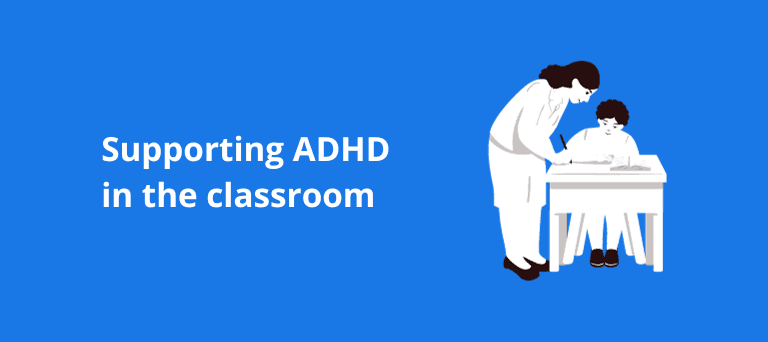Deborah A., Primary School Teacher
1 Oct 2023
5
min read

October – ADHD Awareness month – is a time to reflect on what ADHD is, how it affects people, and how we can collectively celebrate neurodiversity together.
In this article, we will delve into several effective strategies teachers in the UK can employ to support students with ADHD in the classroom.
What is ADHD?
ADHD – an abbreviation for Attention-Deficit/Hyperactivity Disorder – is a neuro-developmental condition that impacts individuals across various age groups. It manifests through symptoms such as inattention, hyperactivity, and impulsivity, which can significantly hinder children's ability to concentrate, organise tasks, and regulate behaviour.
Within the United Kingdom, ADHD poses a considerable challenge for a notable number of children. Statistics indicate that approximately 5-9% of school-aged children in the UK grapple with this condition. Thus, in a classroom comprising 30 students, it is likely that at least one or two pupils will contend with the complexities of ADHD.
Recognising the prevalence of this disorder, it becomes imperative for educators and schools to possess a deep understanding of ADHD and provide the necessary support systems to ensure academic achievement and overall well-being for these students.
What Teachers Can Do To Support ADHD in the Classroom
So, how does a teacher go about supporting a child with ADHD who seems unwilling to sit still and pay attention in the classroom? In this section, we’ll go over some of the strategies teachers can employ to support ADHD in the classroom.
1. Establish Clear and Positive Rules
When communicating classroom rules, it is beneficial to frame them in a positive manner, focusing on what students should do rather than what they should avoid. For example, instead of saying, "No loud talking," you can say, "Please sit down and work quietly, so everyone can concentrate and learn."
2. Implement a Consistent Classroom Routine
Students with ADHD thrive in familiar and structured environments. By establishing a daily classroom routine, you can help students feel more prepared for each lesson and provide them with ample opportunities to concentrate on their tasks. For instance, you can start each day with a "Morning Meeting" where students greet each other and review the day's schedule together.
3. Utilise Visual Aids
Since students with ADHD often respond well to visual cues, incorporating visual aids during teaching can enhance their learning experience. For example, when teaching a history lesson, you can use colourful timelines, maps, and images to help students visualise and better understand historical events.
4. Minimise Distractions
Reducing distractions and disruptions is essential for helping students with ADHD maintain their focus during class. Seat these students toward the front of the classroom, away from doors and potential sources of movement. This way, they can concentrate better without being easily distracted by classmates entering or leaving the room.
5. Simplify Tasks and Instructions
Breaking down tasks into smaller, manageable steps provides students with ADHD with a clear set of goals. For example, when assigning a writing task, you can break it down into steps like brainstorming ideas, outlining, writing a rough draft, and then revising. This approach helps students with ADHD feel less overwhelmed and more confident in completing their work.
6. Allow for Breaks and Movement
Sitting still can be challenging for students with ADHD and may hinder their ability to learn effectively. Incorporating regular breaks for the entire class allows students to stretch and move, providing an opportunity for those with ADHD to regulate and refocus. For instance, you can have short brain breaks where students stand up and do simple stretches or participate in a quick energising activity.
Furthermore, integrating movement into learning activities can help keep students engaged. If you notice a student starting to fidget, consider assigning them a small task that involves moving around the classroom, such as delivering materials to other students or assisting in setting up a hands-on science experiment.
7. Maintain Positive Feedback
Students with ADHD often respond better to regular positive reinforcement rather than consistent reprimands. For example, when a student with ADHD completes a task on time or shows improvement in their behaviour, you can praise them in front of the class, saying, "Great job, Sarah! I appreciate how focused and diligent you were in completing your assignment."
Avoid correcting or reprimanding too quickly. Instead, employ the sandwich approach when offering constructive criticism. Begin by acknowledging what they have done well, provide suggestions for improvement, and conclude by reinforcing their strengths. For instance, if a student with ADHD makes a mistake in a maths problem, you can say, "You did a fantastic job with your calculations, John. Next time, let's double-check our work to ensure we have the correct answer. Keep up the excellent effort!"
Conclusion
Implementing effective classroom management strategies for students with ADHD can create a supportive and engaging learning environment. By setting clear and positive rules, establishing a consistent routine, utilising visual aids, minimising distractions, simplifying tasks, allowing for breaks and movement, and maintaining positive feedback, educators can help students with ADHD thrive academically and socially. By understanding and addressing their unique needs, we can foster their success and create an inclusive classroom where all students can reach their full potential.



